Effect of foliar application of micronutrients and PGR’s on yield and growth characteristics of guava (Psidium guajava L.) cv. Banarasi
Bạn đang xem bản rút gọn của tài liệu. Xem và tải ngay bản đầy đủ của tài liệu tại đây (215.96 KB, 5 trang )
Int.J.Curr.Microbiol.App.Sci (2020) 9(8): 1486-1490
International Journal of Current Microbiology and Applied Sciences
ISSN: 2319-7706 Volume 9 Number 8 (2020)
Journal homepage:
Original Research Article
/>
Effect of Foliar Application of Micronutrients and PGR’s on Yield and
Growth Characteristics of Guava (Psidium guajava L.) cv. Banarasi
M. Thiruppathi*
Department of Horticulture, Faculty of Agriculture, Annamalai University,
Annamalai Nagar- 608002, India
*Corresponding author
ABSTRACT
Keywords
ZnSo4, Borax, GA3,
Guava and Growth
characters
Article Info
Accepted:
15 July 2020
Available Online:
10 August 2020
An experiment was conducted in 12 year old plants field at Dharmapuri (Tamil Nadu)
during the year 2019-20. To studies the effect of foliar application of micronutrients and
PGR‟s on yield and growth characteristics of guava (Psidium guajava L.) cv. Banarasi.
The experiment was laid out Randomized Block Design with ten treatments and replicated
thrice with a unit of one plant in each replication of a treatment. Different doses of (ZnSo 4)
@ 0.25%, 0.5% and 0.75%, Borax @ 0.2%, 0.4% and 0.6% and GA3 @ 50 ppm, 75ppm
and 100ppm with control (water sprayed) were sprayed before flowering and after fruit set.
The present study it can be concluded that the Borax 0.6% followed by 0.4% significantly
increased the flowering per shoot (56.83), fruit set (65.4%), fruit retention (56.78%), fruit
weight (142.5g), fruit length (6.43cm), fruit width (6.31cm) and fruit yield (65.13
kg/plant).
Introduction
Guava (Psidium guajava L.) belongs to
family Myrtaceae is one of the important
tropical and sub-tropical fruit of India. It is
also known as “apple of tropics” and poor
man‟s apple. Its nutritive values are very high,
therefore, considered an ideal fruit for
nutritional security and one of the cheapest
and good source of vitamin 'C' (260 mg
/100g).It has been in cultivation in India since
17th century and has originated in tropical
America perhaps from Mexico to Peru and
introduced in India by Portuguese. The total
cultivated area of guava in India is 276
thousand hectares with an annual production
of 4236 thousand MT (NHB 2018-19).Guava
is hardy fruit plant which can be grown in
poor alkaline or poorly drained soils. It gives
ripen fruits mainly in two seasons of rains and
winter. The rainy season crop is rough,
insipid, poor in quality and less nutritive,
whereas winter season crop is superior in
quality having long storage life and fetches
more price in the market (Rathore and Singh,
1976). Guava fruit is considered as one of the
delicious and luscious fruit. It is also good
source of pectin (0.78%) and growth
regulators and micronutrients play a vital role
in growth and development of fruit trees and
very effective in manipulating cropping
season, improving fruit set, fruit retention and
1486
Int.J.Curr.Microbiol.App.Sci (2020) 9(8): 1486-1490
quality of guava fruits. Being perishable
nature of ripe fruit, it is essential to improve
the quality of guava fruits which may be
helpful in prolongation of shelf life of fruits.
Several research workers have observed
certain pre-harvest treatments which helped in
improving the quality of fruits at harvest and
enhanced the storage life by influencing the
post-harvest changes (Chaitanya et al., 1997).
Materials and Methods
12-year-old guava plants were taken for the
investigation Effect of foliar application of
micro nutrients and plant growth regulators
on yield and growth characters. Twelve years
old uniform guava plants planted at 6 x 6m
space were selected for investigation.
Nutrients application and other orchard
management practices were followed as per
recommended package of practices for guava
plants. First spraying of micro nutrients and
plant growth regulators were done before
flowering (third week of August) and second
after fruit set (last week of September) during
2019-20.Thus there were total ten treatments
including (to water spray), T1ZnSo4@ 0.25%,
T2ZnSo4 @ 0.5%, T3ZnSo4 @ 0.75%,
T4Borax @ 0.2%, T5Borax @ 0.4%, T6Borax
@ 0.6%,T7 GA3 @ 50ppm, T8 GA3 @ 75
ppm, T9GA3 @ 100 ppm. The experiments
was laid out in Randomized Block Design and
replicated thrice taking a single tree as a unit.
At harvest, a representative. Sample of
twenty-five greenish yellow color mature
fruits were taken randomly from three trees of
each treatment and the observations on
various physical attributes were recorded.
Analysis of variance (one way classified data)
for each parameter was performed using
„DISAAT‟ software. The data collected on
different crop characters were analyzed
statistically in randomized block design as
suggested by Panse and Sukhatme (1985).The
significance of different sources of variation
was tested by error mean square by Fischer-
Snedecor‟s „F‟ test at probability level of 5
percent (p=0.05).
Results and Discussion
Effect on flowering, Fruit set and fruit
retention
It has been observed that 0.6% borax was
most effective in increasing flowering per
shoot (56.83), fruit setting (65.40%) and fruit
retention (56.78%) followed by 0.4% of borax
(Table 1). The increase in yield might due to
direct
or
indirect
involvement
of
micronutrients in photosynthesis, fruit setting,
retention, reduction in drop as well as growth
and development of fruits caused by foliar
sprays of zinc and boron (Abhijith et al.,
2018). Increasing levels of borax spray also
increased the number of flowers per shoot,
fruit set and fruit retention percentage with
upto highest level of 0.6% borax solution
spray but margin of increase beyond 0.4%
borax spray was not found significant on
flowers per shoot and fruit set percentage.
However fruit set and fruit retention
percentage was recorded on par each other
with treatment T5 and T6solution spray. It
might be due to the reason that these nutrients
play an important role in translocation of
carbohydrates and in auxin synthesis to the
sink and increase pollen viability and
fertilization (Dewanshu et al., 2017). These
results are in accordance to the findings of
Raj Kumar et al., (2010), Panwar et al., 1995)
and in litchi (Babu and Singh, 2001).
Effect on fruit length, width, weight and
yield
It has been observed that boron 0.6% spray
increase fruit weight (142.50g), length
(6.43cm) and width (6.31cm) and fruit yield
(65.13kg/plant) of guava maximum fruit
cultivar Banarasi, it‟s treatment T6 and T5 on
par with each other (Table 2). This increase in
1487
Int.J.Curr.Microbiol.App.Sci (2020) 9(8): 1486-1490
length and breadth of guava fruit may be due
to the mineral nutrients specially boron
appears to have direct role in hastening the
process of cell division and cell elongation
due to which size and weight would have
improved. The increase in fruit weight may be
due to the rapid increase in the size of cells
and the increase in the fruit yield was due to
the accumulation of sugars and other soluble
solids in the fruits (Sukhjitkaur, 2017).
Table.1 Effect of foliar application of micronutrients and PGR‟s on flowering and fruiting
behavior of guava
Treatments
T1 - ZnSo4 @0.25%
T2 - ZnSo4 @0.50%
T3 - ZnSo4 @0.75%
T4 - Borax @ 0.2%
T5 - Borax @ 0.4%
T6 - Borax @ 0.6%
T7 - GA3 @ 50 ppm
T8 - GA3 @ 75 ppm
T9 - GA3 @ 100 ppm
T10 - Control
S.Ed
CD at 5%
Flowering
per shoot
53.55
55.64
56.15
54.61
56.61
56.83
53.10
54.10
55.13
52.71
1.02
2.14
Fruit set
(%)
54.95
60.17
61.62
58.03
63.15
65.40
53.46
56.43
59.60
51.10
1.10
2.28
Fruit
retention (%)
46.20
52.37
54.15
49.03
55.95
56.78
44.62
48.17
50.73
41.38
0.94
1.96
Table.2 Effect of foliar application of micronutrients and PGR‟s on fruit
characters and yield of guava
Treatments
Length of
fruit
(cm)
5.97
T1- ZnSo4 @0.25%
6.27
T2 - ZnSo4 @0.50%
6.33
T3- ZnSo4 @0.75%
6.14
T4- Borax @ 0.2%
6.40
T5- Borax @ 0.4%
6.43
T6- Borax @ 0.6%
5.90
T7- GA3 @ 50 ppm
6.08
T8- GA3 @ 75 ppm
6.21
T9- GA3 @ 100 ppm
5.79
T10- Control
0.11
S.Ed
0.23
CD at 5%
Width of
fruit
(cm)
5.74
6.11
6.20
5.93
6.28
6.31
5.68
5.82
6.02
5.60
0.11
0.23
1488
Fruit
weight
(g)
130.57
138.11
139.94
134.35
141.77
142.50
128.63
132.42
136.28
125.94
2.51
5.27
Fruit
yield/plant
(kg)
55.00
61.58
63.13
58.43
64.58
65.13
53.70
56.68
60.08
52.38
1.10
2.31
Fruit
yield/ha
(tone)
15.29
17.20
17.55
16.24
17.95
18.11
14.93
15.76
16.70
14.56
0.31
0.64
Int.J.Curr.Microbiol.App.Sci (2020) 9(8): 1486-1490
The increase in the size of fruits was due to
the rapid fruit development and the greater
mobilization of food materials from the site of
production to storage organs under the
influence of applied nutrients. Kumar et al.,
(2004) advocated that foliar application of
borax (0.4 and 0.6%) significantly improve
fruit length, diameter and fruit weight in litchi
cv. Dehradun and Singh et al., (2004) found
that foliar spray of boric acid (0.4%)
considerably increased size and weight of
guava fruit in comparison to control. Banik et
al., (1997) found that foliar application borax
0.4% significantly increased length, width and
weight in mango cv. Fazli.
Fruit length, width, weight, volume and yield
per plant were recorded significantly highest
values with highest level of 0.6% borax
solution spray. It is believed that boron
improves the physiological activities of plant
which might have improved size, weight,
volume of fruits and ultimately higher fruit
yield per plant. Besides, fruit yield per plant is
also attributed to fruit retention percentage.
Thus, fruit yield per plant seems to be the
combined effect on single fruit weight and
number of fruits per plant. The application of
zinc and boron might have caused rapid
synthesis of protein and translocation of
carbohydrate which ultimately led to increase
in fruit weight which is directly correlated
with total yield (Singh et al., 2012). These
results corroborate with the findings of Prasad
et al., (2005). Similar results have been
reported in aonla (Ram et al., 1977; Dashora
et al., 2005).
In conclusion the result of present study may be
concluded that foliar spray of Borax @ 0.4 –
0.6% solution on guava plants twice i.e. once
before flowering (third week of August) and
again after fruit setting (last week of September)
are beneficial to found to be most effective for
overall increment of flowering, fruit set, fruit
retention, yield and quality attributes.
References
Anonymous. NHB, Database, Gurgaon,
Haryana, 2018-19.
Babu, N. and Singh, A. R., 2001, Effect of
foliar application of boron, zinc and
copper on chemical characterization of
litchi fruits. Bioved., 12 (1/2): 45-48.
Banik BC, Sen SK, Bose TK. Effect of zinc,
iron and boron in combination with
urea on growth, flowering, fruiting
and quality of mango cv. Fazli.
Environ. Eco-B. C.K.V., Kalyani.
1997; 15(I):122-125.
Chaitanya, C.G., Kumar G., Rana, B.L. and
Mathew, A.K. (1997). Effect of foliar
application of zinc and boron on yield
and quality of guava Cv. L-49.
Haryana Journal of Horticulture
Science, 26 (1-2): 78-80.
Dashora, L. K., Lakhawant, S. S. and
Aravindakshna, K., 2005, Effect of
foliar spray of zinc and boron on yield
and quality of aonla. National seminar
on commercialization of Horticulture
in non-tradition Areas, Bikaner, Feb.
85: 5-6.
Dewanshu B, S. tomar, Singh J.P. and
Maurya, J.K., (2017), Effect of foliar
application of zinc and boron on fruit
growth, yield and quality of winter
season guava (Psidium guajava L.).
International Journal of Current
Microbial Applied Science 6(9): 15251529.
Kumar S, Kumar S, Verma DK. Effect of
micro-nutrients and NAA on yield and
quality of litchi (Litchi chinensis
Garentn) Sonn cv. Dehradun. Abst in
Proc. of International Seminar on Rec.
Trend in Hi-Tech Horticulture and
PHT, originated by C.S.A.U.A. & T.,
Kanpur. 2004; 4-6:193.
Panse, V.G., and Sukhatme, P.V. (1985).
Statistical Methods for Agriculture
Workers. ICAR, New Delhi.
1489
Int.J.Curr.Microbiol.App.Sci (2020) 9(8): 1486-1490
Panwar, R. D., Saini, R. S., Kaushik, R. A.
and Yamdagni, R., 1995, Effect of
micronutrients on fruit retention, yield
and quality of aonla cv. Banarasi
under rainfed condition. Haryana
Journal of Horticultural Science, 22
(1-2): 250-251.
Prasad, B., Das, S., Chatterjree, D. and Singh,
U.P. (2005). Effect of foliar
application of urea, zinc and boron on
yield of guava. Journal of Applied
Biology, 15 (1): 44-47.
Rajkumar Tiwari, J.P. and ShantLal, (2010).
Effect of foliar application of zinc and
boron on fruit yield and quality of
winter season guava (Psidium guajava
L.) Cv. Pant Prabhat. Annals of
Agricultural Biology Research, 19 (1):
105-108.
Ram, S., Dwivedi, J. S. and Bist, L. D., 1977,
Internal fruit necrosis in aonla
(Emblica
officinalis
Gaertn.).
Progresssive Horticulture, 8 (3): 5-12.
Rathore, D.S., and Singh, R.N. 19976. Yield
pattern in tree cropping patter of
guava (Psidium guajava L.). Indian
Journal of Horticulture, 33: 7-13.
Singh R, Chaturvedi OP, Singh R. Effect of
pre-harvest spray of zinc, boron and
calcium on the physico-chemical
quality of guava fruit (Psidium
guajava L.). International Seminar on
Recent Trend on Hi-Tech Horticulture
and P.H.T., Kanpur, February. 2004;
4-6:2004-204.
Singh, P. C., Gangwar, R. S. and Singh, V.
K., 2012, Effect of micronutrients
spray on fruit drop, fruit quality and
yield of aonla cv. Banarasi.
Hortultural Flora Research Spectrum,
1(1): 73-76.
Snedecor, G. W. and W.G. Cochran (1968).
Statistical Methods. Ox ford and IBH
Pub. CO. Kolkata. 469p.
Sukhjit Kaur, (2017), Effect of micronutrients
and plant growth regulators on fruit
set, fruit retention, yield and quality
attributes in litchi cultivar Dehradun.
Chemical Science Review lettters
6(22), 982-986.
Abhijith, Y.C., J. Dinakara Adiga, H. Kishor
and C. Sindhu, (2018), Effect of
micronutrients on yield and quality of
aonla (Emblica officinalis Gaertn.) cv.
NA-7. International Journal of
Current Microbiology and Applied
Science 7(3): 140-145.
How to cite this article:
Thiruppathi, M. 2020. Effect of Foliar Application of Micronutrients and PGR‟s on Yield and
Growth
Characteristics
of
Guava
(Psidium
guajava
L.)
cv.
Banarasi
Int.J.Curr.Microbiol.App.Sci. 9(08): 1486-1490. doi: />
1490
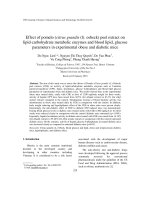
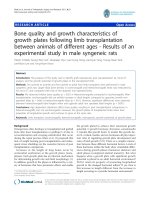
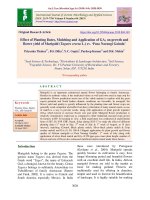
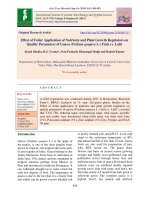

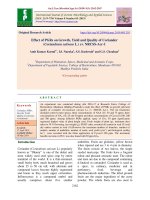
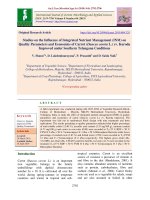
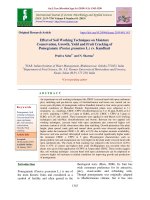

![Effect of post harvest treatments on the shelf life and quality of guava [Psidium guajava (L.)] cv. Allahabad Safeda](https://media.store123doc.com/images/document/2020_01/14/medium_wgi1578938512.jpg)